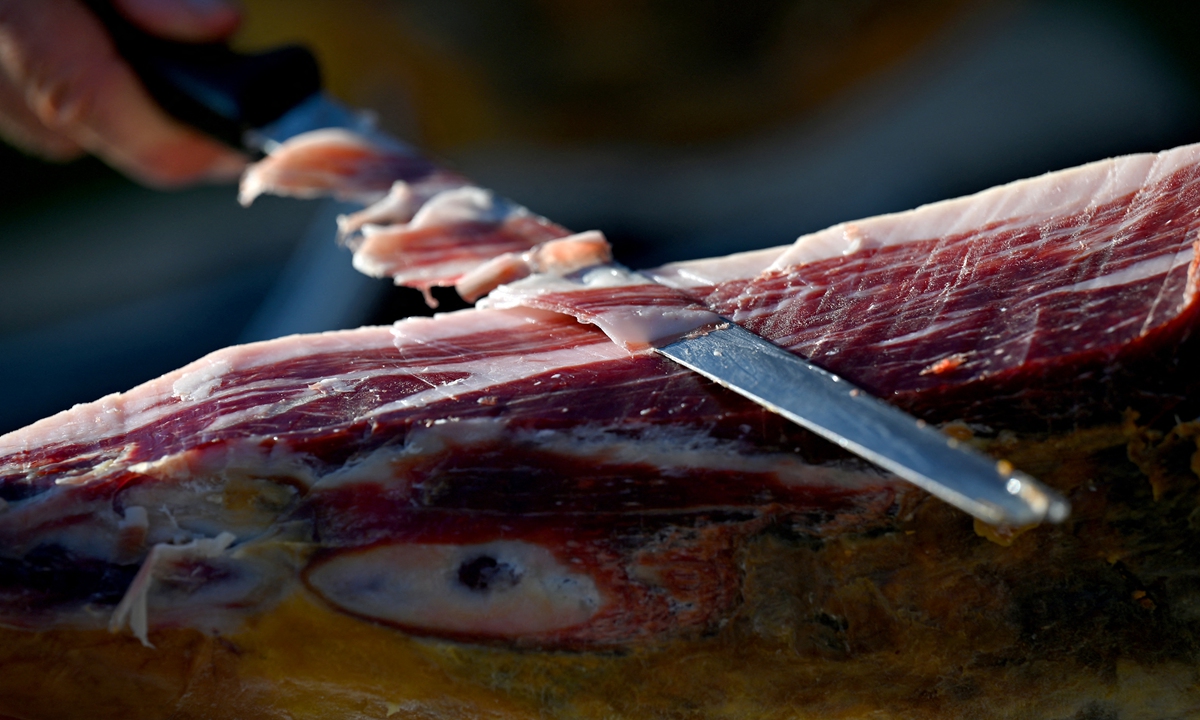
Spanish master ham cutter Florencio Sanchidrian cuts Spanish Iberian ham in Membrio, near Caceres, on January 18. Photo: AFP
The sun is shining as Salvador Pereira Menaut's pigs trot between the oak trees in search of acorns - but he does not look happy.
Sales of premium
pata negra dry-cured hams, the "caviar" of Spanish charcuterie, have suffered as restaurants and hotels have closed and celebratory events where it is usually eaten have been put on ice because of the pandemic.
And that has pushed down the value of the hams made by Navarretinto, the company Pereira runs, as well as the 13,000 Iberico pigs raised each year in the sparsely populated region of Extremadura in southwestern Spain.
"We had managed to carve out a place for ourselves in the best restaurants and hotels in Madrid. But almost all of them have closed since the start of the pandemic and they no longer buy," he told AFP.
A cured leg of
pata negra can sell for more than 500 euros ($600) but restaurants are now paying 30 percent less for the delicacy than they did before the pandemic.
This amount does not cover the cost of the pigs' feed during the summer months when there are no acorns, Pereira explains.
Navarretinto only transforms a small part of the pigs it raises into hams, and sells the rest to other ham producers. But the price of pigs has also dropped.
Since the pandemic hit in 2020, the price Spanish pig farmers receive for their livestock has plunged 20-25 percent, according to the ASICI association of pork producers.
And the plunge in price for purebred Iberico pigs like those raised by Pereira is around 50 percent.
"If this goes on for too long, it's possible some [breeders] will disappear, including us," he said.
No more parties
Farming cooperatives in Andalusia, the main region that produces cured ham, estimate sales have halved within Spain and the loss for pig breeders in 2020 stands at a whopping 250 million euros.
"The industry is facing a lot of uncertainty because it doesn't know what it's going to sell," said ASICI President Antonio Prieto, pointing out that "all traditional and family parties have been canceled" and many restaurants have closed.
Curing a ham takes a minimum of two to three years so ham makers are paying less for pork because they don't know how much they will be able to charge for the end product, he explained.
And
cortadores - those masters skilled in the art of finely slicing dry-cured legs of ham - have also been hit hard.
Their skill lies in cutting ham into slices so thin that they are almost transparent, called
lonchas, or chunks called
tacos, and they are often hired to staff special events.
"It affects us a lot because there are no more ceremonies, weddings, banquets, ferias or business meals," said Florencio Sanchidrian, Spain's most famous
cortador.
Exports also hitPereira has set up an online sales service but said it is "not enough" to make up for the fall in sales through traditional channels.
His small firm's efforts to boost exports to make up for declining business in Spain have also struggled owing to travel restrictions preventing its sales manager from going abroad to meet potential new customers.
Exports of Spanish dry-cured hams of all grades fell about 3 percent year-on-year in volume in 2020, according to ASICI.
The pandemic is reviving fears of a repeat of the 2008 global financial crisis, which pushed thousands of small ham producers into bankruptcy.
But Prieto said the sector has become more professional, with a system in place to quickly inform farmers of changes in market conditions so they can reduce production when prices fall.
"We may lose money, or not earn the money which we should, that's for sure," he said.
"But there have been no closures so far, even if each farm is earning less."




